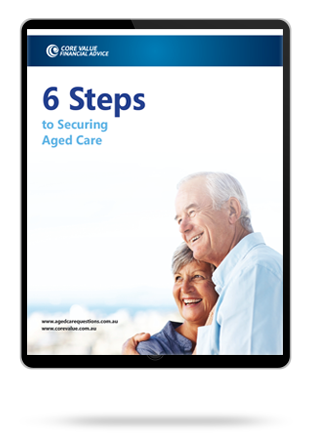The way you structure your income and assets can greatly impact your aged care Means-Tested Care fee.
But what is the Means-Tested Care fee and how does it work?
In This Article
What is the Aged Care Means-Tested Care Fee?
The aged care Means-Tested Care fee is a fee payable by aged care residents to assist with the costs associated with aged care.
An individual’s aged care costs are largely supported by the government. The Means-Tested Care fee is designed to calculate a resident’s contribution towards those costs, based on their level of means.
The Means-Tested Care fee is payable in addition to other aged care costs, such as the Basic Daily Care fee, Refundable Accommodation Deposit (RAD), Daily Accommodation Payment (DAP) and Additional Services Fee.
Do I Have to Pay the Means-Tested Care Fee?
Not everyone is required to pay a Means-Tested Care fee. Upon entry to residential aged care, you are required to submit an Income and Assets assessment form to Centrelink.
Centrelink will then calculate your Means Tested Care fee based on your income and assets and that will be an additional cost incurred by you while in care.
The Means-Tested Care fee calculation is continuously assessed, meaning the actual Means Tested Care fee that you pay can vary each month according to your income and asset assessment.
So, how is the Means-Tested Care fee calculated?
How is the Means-Tested Care Fee Calculated?
Your Means-Tested Care fee amount is arrived at through a combination of your income and assets within the one assessment.
To know what your Means-Tested Care fee will be, you first need to understand what your Means-Tested Amount (MTA) is.
Specifically, your MTA is calculated using the following formula:
| Income-Test Component |
| 50% of your Assessable Income in excess of the ‘Income Free Area’ (currently $32,331) |
| Plus |
| Asset-Test Component |
| 17.5% of your Assessable Assets between the Asset-Free Threshold ($58,500) and the First Asset Threshold ($197,735) |
| Plus |
| 1% of your Assessable Assets between the First Asset Threshold ($197,735) and the Second Asset Threshold ($476,206) |
| Plus |
| 2% of Your Assessable Assets in excess of the Second Asset Threshold ($476,206) |
| = Means-Tested Amount (MTA) Per Year |
*The figures are based on
Once you have calculated your MTA, you then need to take the Maximum Accommodation Supplement Amount (MASA) – which is currently $66.94 per day – away from the MTA.
This figure will then be your daily Means-Tested Fee amount.
Means Tested Care Fee Example
To give you an example of how the Means-Tested Care fee is applied, let’s look at the following scenario:
Beryl, a widower, is moving into residential aged care. She has personal assets of $5,000, and financial assets of $500,000, which are deemed to earn $10,042 p.a. Plus, Beryl receives Centrelink Age Pension payments of $1,064 per fortnight.
| Income-Test Component |
| 50% of ($37,706 – $32,331) = $2,687.50 |
| Plus |
| Asset-Test Component |
| 17.5% of ($197,735 – $58,500) = $24,366 |
| Plus |
| 1% of ($476,206 – $197,735) = $2,784.71 |
| Plus |
| 2% of ($500,000 – $476,206) = $475.88 |
| = $30,314.09 Per Year |
The Means Tested Care fee is then calculated as ($30,314.09 / 365) – $66.94 = $16.11 per day.
However, when it comes to the MTF, there is a maximum annual cap and lifetime cap amount.
Is the Means-Tested Care Fee Capped?
The Means-Tested Care fee has both an annual and lifetime cap.
The current annual cap at 1 January 2024 is $32,718.57. This is the maximum aged care Means-Tested Care fee that needs to be paid in any one year.
If the annual cap is met in any one year, no further Means-Tested Care fee needs to be paid for the remainder of the 12-month period.
The current lifetime cap at 1 January 2024 is $78,524.69. This is the maximum Means-Tested Care fee that needs to be paid by any one resident over the course of their life.
If the lifetime cap is reached, no further Means-Tested Care fee is payable ever again.
Ways to Reduce the Means-Tested Care Fee
Reduce the Means-Tested Care fee involves minimising the level of your assessable income and assets. There are a number of ways to do this, including:
- Contribute more to the RAD – While paying more to the Refundable Accommodation Deposit will not reduce the asset test component of the Means Tested Care fee calculation, it will reduce the income test component.
- Retaining a former-home – There is a limit on how much of a former home is counted under the assets test component for Means-Tested Care fee purposes
- Gifting strategies – gifting to family within the gifting limits can reduce both your assessable income and assets for Means-Tested Care fee purposes.
- Prepaying funeral – Prepaying for a funeral will reduce your assessable income and assets based on the cost. A funeral bond will, also, but a limit will apply to funeral bonds.
- Certain retirement products – There are certain types of retirement income stream products that can be favourably assessed for Means-Tested Care fee purposes.
It’s important to understand that there are downsides associated with each of the strategies above, so it’s important to seek advice from a specialist aged care adviser, prior to implementing any of these.
At Core Value Aged Care Advice we will help you navigate the complexities of aged care and find the best financial solutions for your family. If you have any questions or concerns regarding your situation, please call us on 1300 944 011 or contact us here to speak to an expert aged care adviser.
You might also like:

Hi, I hope you found this article useful.
If you wish to discuss your situation and what strategies may be of benefit please contact us here
Thanks - Shane


